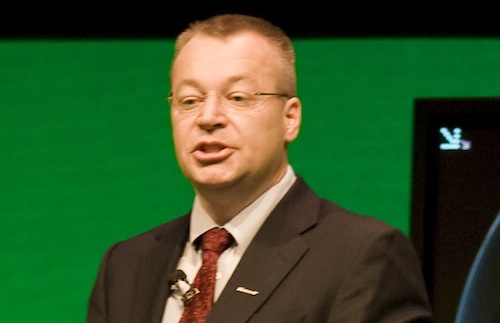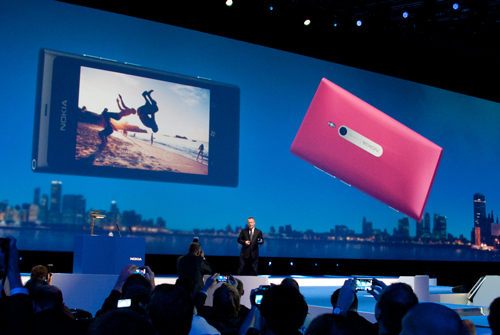
Finnish handset manufacturer Nokia unveiled six new handsets at its annual Nokia World event in London on Wednesday. The devices include the Lumia 800 and 710, smartphones running the Windows Phone 7.5 “Mango” operating system, and four feature phones that Nokia calls the Asha series.
Nokia CEO Stephen Elop told delegates that the products heralded a “new dawn for Nokia”, which has failed to keep pace in the smartphone market against rivals like Apple, with iOS, and Google, with Android.
“Earlier this year we recognised the need to shift our mobile strategy,” Elop says. “We want people to feel and expect something special when they hear the word Nokia, but this simply wouldn’t happen without change.”
Elop says the company took the decision to “transition” its smart devices platform to Windows Phone from Microsoft and describes the move as “playing to win”.
Nokia sold 18m devices in the third quarter from what Elop calls a “standing start”. Some of the most successful among these have been Nokia’s five dual-Sim devices. Elop says there’s been a subsequent “halo effect” in that “the success of dual-Sim products is also driving sales of other devices”.
Nokia also launched six new Symbian devices during the same period, suggesting the company has no plans to abandon the feature-phone platform in the near future. It also added seven new near-field communications, or NFC, devices to its product list.
Nokia’s recent button-less touch-based smartphone, the N9, has enjoyed strong demand, according to Elop. “In Russia, we saw our highest preorders ever.”
Elop says the big question facing Nokia has been how to “connect the next billion people to the Internet” and it realises that for many it will be first experience of Internet.
“But who are the next billion? It’s a really young crowd,” says Elop. He says Nokia expects “high growth in emerging markets”, adding that the company is making 12 phones every second or 1m a day.
Elop says Nokia is introducing four new mobile phones in what it calls the Asha series. The range is made up of the 200, 201, 300 and 303.
Blanca Juti, vice-president of mobile phone marketing, says Nokia wants to “bring data to people who have never had it before”.
The Asha 201 is a dual-Sim phone with a Qwerty keyboard. The 200 has the same form factor but doesn’t include dual-Sim support.
Both models include up to 32GB of on-board memory and Nokia claims 52 hours of battery life on the 200 series.
The Asha 300 is a candy-bar form-factor phone with a physical keyboard and touchscreen. The 303 has a Qwerty keyboard and a touchscreen, a 1GHz processor, support for Wi-Fi and 3G, and Nokia Maps preinstalled.
Juti says 30% of the downloaded applications in the Nokia Store are from S40 devices. She says the Ovi Store, Nokia’s app store, will now offer users of Nokia S40 devices popular messaging service WhatsApp and the game Angry Birds.

All Asha devices come with a Nokia browser preinstalled that compresses data. Nokia claims compression reduces data usage by up to 90%.
Elop says the line is blurring between smartphones and feature phones. “But we still know there is space in the core design of smartphones for innovation.”
The big announcement on Wednesday was Nokia’s new Windows Phone-powered Lumia 800 (US$585), styled on the recently released N9 that runs MeeGo. Elop says it’s the first device to “maximise the possibilities” of the Windows Phone platform. “Lumia is the first real Windows Phone”.
Kevin Shields, senior vice-president of programme and product management for smart devices, says the Lumia 800 “screams premium” and in a dig at the problems the plagued the early iPhone 4 from Apple, Shields say that the Lumia “delivers outstanding antenna performance”.
In another dig at Apple, Shields says the first thing users will notice about the Lumia is that there are dynamic tiles, rather than a “lame grid of application icons that sit there doing nothing” on its home screen.
Shields says the Lumia’s camera includes a Carl Zeiss lens with aperture of f2.2 and LED flash. It also includes Microsoft Office support and integrates with Microsoft’s cloud-based SkyDrive that offers users 25GB of free storage.
The Lumia is focused on navigation, music and sports and includes Nokia Drive, Nokia’s turn-by-turn voice-guided navigation system, which comes preinstalled. The device also includes a new app called Nokia Music that includes a feature called Mix Radio that offers predefined “mixes” that can be streamed for free and doesn’t require a sign-up process.
Users can also opt to download the mix for offline playback.
The company also unveiled new headsets designed in partnership with headphone manufacturer Monster.
Shields says the Nokia Lumia will also include a service called “ESPN Sports Hub” that offers users in-depth information about various sports, events and players.
The company also took the wraps off the Lumia 710 which it is pitching as an “affordable smartphone”. It has a 3,7-inch LCD touch display. The 710 will also include the navigation, music and sports applications of the 800. It offers interchangeable rear covers.
Elop says Nokia has “scrutinised” every aspect of its new devices and the focus has been on “functionality” and the new devices represent a “new dawn for Nokia”. He says Nokia believes maps and navigation are building blocks to connect “the real world with the virtual world” and that the company is looking to include increasing amounts of “contextual knowledge”.
Nokia is also launching a public transport application that offers real-time transport information for 71 cities and Nokia LiveView that offers “reality augmentation” information using handsets’ built-in cameras. Elop says more information about LiveView will follow on Thursday.
The company says it plans to introduce LTE (long-term evolution) and CDMA (code division multiple access) products in specific markets next year. SA users can expect to see the new devices in early 2012. — Craig Wilson, TechCentral
- Subscribe to our free daily newsletter
- Follow us on Twitter or on Facebook
- Visit our sister website, SportsCentral (still in beta)




